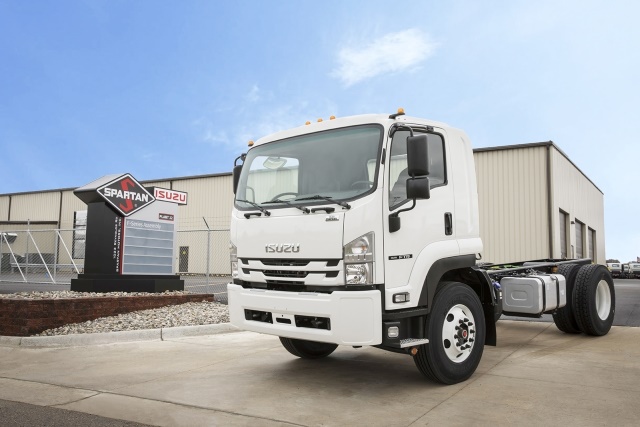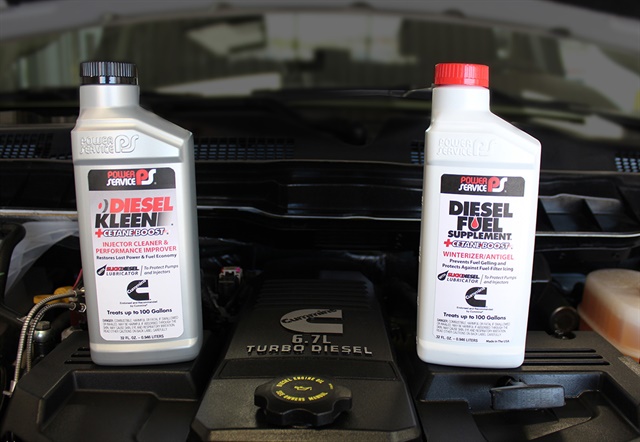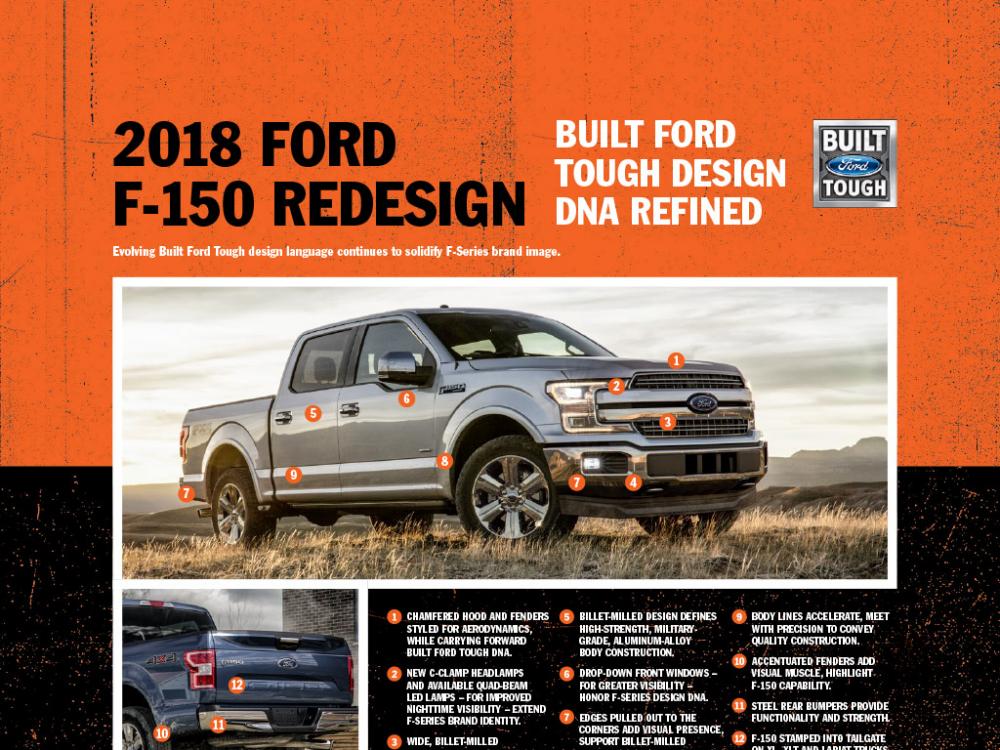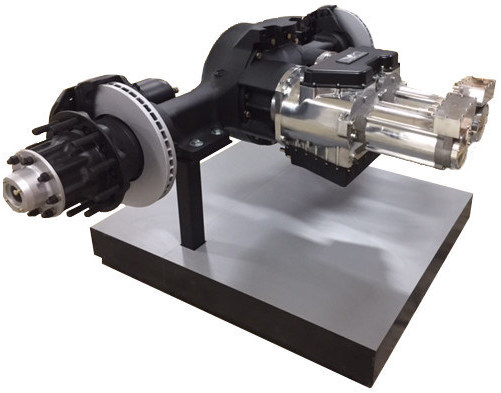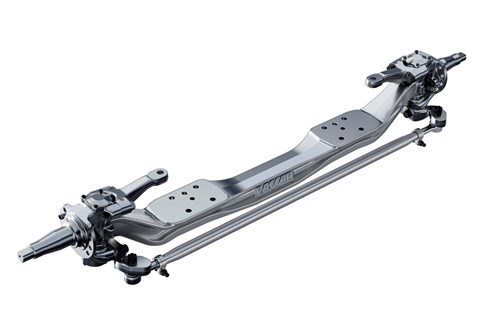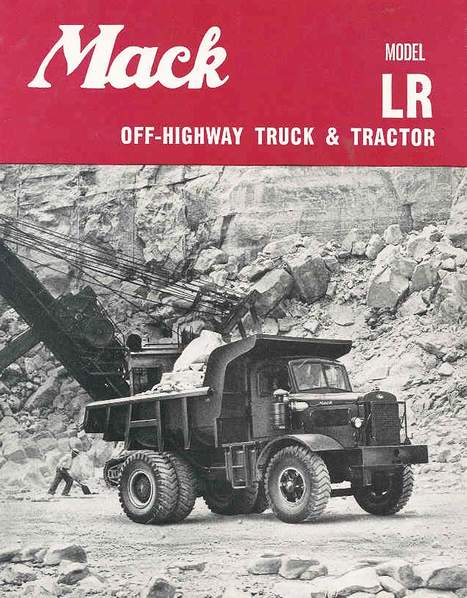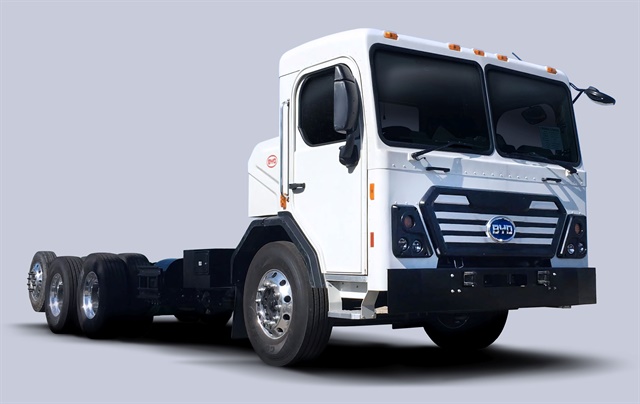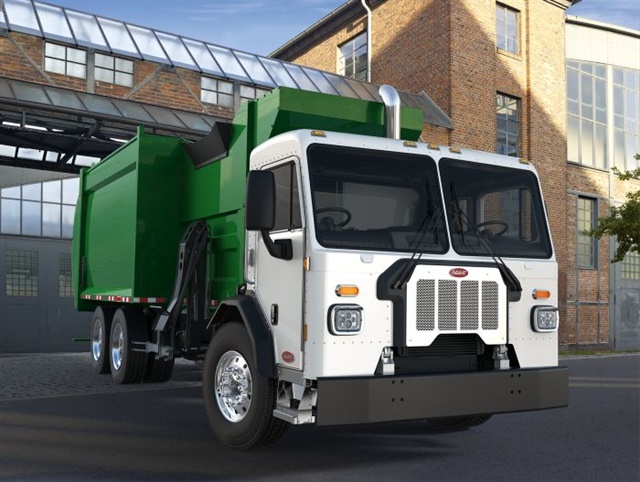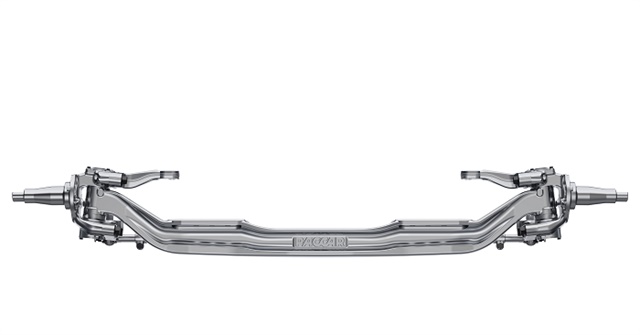
kscarbel2
Moderator-
Posts
18,927 -
Joined
-
Days Won
114
Content Type
Profiles
Forums
Gallery
Events
Blogs
BMT Wiki
Collections
Store
Everything posted by kscarbel2
-
Owner/Driver / May 10, 2017 Road upgrades and proactive safety initiatives are high on the road transport industry’s wishlist, but both require all-important funding. Last night’s Federal Budget saw infrastructure spending high on the agenda, with a number of road and rail upgrades set to better connect regional and metro Australia. Federal Treasurer Scott Morrison spoke passionately about the importance of infrastructure as he handed down his second Federal Budget, with a slogan to boot: "To support growth we choose to invest in building Australia, rail by rail, runway by runway and road by road." "It is important to invest in infrastructure…but we have to make the right choices on projects, proving the case to ensure they are part of a broader economic growth strategy," Morrison said. The Treasurer did his best to quell concerns that infrastructure spending can sometimes be misguided, outlining plans for a new agency to oversee project financing. "Our new infrastructure and projects financing agency will help us make those right choices, recruiting people with the commercial expertise to ensure we use taxpayers’ money wisely," he said. A total of $75 billion in funding has been allocated to infrastructure developments over the next ten years, with a good portion of that detailed in this year’s budget. In Queensland, $844 million will be used to upgrade the Bruce Highway including $530 million for works on the section from Pine Rivers to Caloundra. The M1 Pacific Motorway, Gateway Upgrade North, Toowoomba Second Range Crossing, Warrego Highway and Northern Austral Roads Programme will also receive funding for long-awaited works. Minister for Main Roads and Road Safety Mark Bailey says the Queensland funding falls short of what is needed for what is the largest state road network in the country. "I am disappointed we didn’t get our NARP funding back for regional roads in North and Western Queensland," Bailey said. "Six months ago, the Turnbull Government ripped-off Queensland by around $150 million in promised roads funding under the Northern Australia Roads Programme (NARP). "This means projects benefiting truckies like installing overtaking lanes or improving heavy vehicle safety on the Flinders Highway between Townsville and Charters Towers missed out, as well as funding for Heavy vehicle rest areas and stopping places on the Landsborough Highway between Barcaldine and Cloncurry. "A list of initiatives on Infrastructure Australia’s priority list also missed out on funding including the remaining sections of Ipswich Motorway Rocklea-Darra upgrade, Cunningham Highway – Yamanto to Ebenezer/Amberley upgrade and other Brisbane to Gold Coast transport corridor upgrades. These upgrades would be of great benefit to Queensland and Australia’s freight and supply chain productivity." Over in Western Australia $1.6 billion in Commonwealth funds has been invested for better roads access and the government has committed $237 million of that for the Kwiwana freeway as well as $100 million for an access road upgrade near the Fiona Stanley Hospital. Victoria has had $1 billion made available for regional rail and infrastructure projects, with most of that money going to rail. The Tullamarine Freeway widening will see $112 million in 2017-18, the Western Freeway will get $77 million in 2017-18 and the Princes Highway West and East will see improvements. Following a joint Victorian and Federal Government agreement late last year, the Monash Freeway upgrade, completion of the M80 Ring Road upgrade, Rural and Regional Roads Package and Urban Congestion Package will receive Federal support. New South Wales will inject $710.1 million in 2017-18 to the Pacific Highway duplication and a number of Regional Road Freight Corridor projects have received funding under the Commonwealth’s Asset Recycling Initiative. The Northern Territory Roads Package will receive funding, along with the Regional Roads Productivity Package. South Australia and Tasmania saw modest road upgrade funding, with money committed to South Australia’s North-South Corridor projects and Tasmania’s Midland Highway. The National Heavy Vehicle Regulator (NHVR) received the ongoing $3.9 million for their Heavy Vehicle Safety Initiative – funds redirected from the abolished Road Safety Remuneration Tribunal (RSRT). "I believe this budget will allow the NHVR to continue with our work to improve heavy vehicle safety and improve productivity for Australia’s heavy vehicle sector," NHVR chief executive Sal Petroccitto said. "In particular we welcome the on-going investment in the $3.9 million Heavy Vehicle Safety Initiative, as well as the freight-enhancing infrastructure and road safety programs outlined in the budget" The Australian Trucking Association (ATA) welcomed Budget announcements surrounding safety measures and infrastructure improvements. "The Government was re-elected in 2016 with a commitment to continue funding the Heavy Vehicle Safety and Productivity, Roads to Recovery, Black Spot and Bridges Renewal programs beyond 2019-20," ATA Chair Geoff Crouch said. "These programs are highly cost effective and deliver safety improvements such as truck rest areas, roundabouts and street lights at dangerous places on our roads. Meanwhile, the Bridges Renewal Program is upgrading bridges that are critical to truck access to local communities. "The 2017-18 Budget confirms that these programs will continue through to 2020-21. Their safety benefits will continue to flow." The ATA also highlighted positive implications of the small business asset write-off extension for trucking businesses. "The vast majority of trucking businesses are small businesses. 94 per cent have a turnover of $2 million or less," Crouch said. "The Government’s decision to extend the instant asset write-off to 30 June 2018 will benefit many eligible businesses." National Transport Minister Darren Chester confirmed that the Government provided an extra $16 million to extend the Keys2drive program, providing around 200,000 free lessons to learner drivers as well as conducting an inquiry into the National Road Safety Strategy. The Australian Government will also continue to fund the Black Spot Programme with $684.5 million from 2013–14 to 2020–21 so it can continue to deliver safety improvements around dangerous sections of road. As far as funding not specifically roads-related but relevant to the road transport industry, the Western Sydney airport and the Melbourne to Brisbane in-land rail project will both go ahead. The Western Sydney airport planned for Badgery’s Creek will commence works in 2018 following the allocation of $5.3 billion in equity. The hotly-debated Melbourne to Brisbane in-land rail project, to be delivered by the Australian Rail Track Corporation (ARTC), was provided with $8.4 billion in funding. The 17,000 kilometre rail project will begin this year and is projected to support 16,000 jobs during the peak of construction. Concerns for the road transport industry with the introduction of an in-land rail project connecting Brisbane and Melbourne remain, but Livestock, Bulk and Rural Carriers Association (LBRCA) President Lynley Miners suggests it may actually support trucking jobs. "Some commodities can go on rail and it works with heavy stuff like grain and coal, but time-dependent goods will still rely on trucks," Miners said. "Road transport will also play a big part of building the in-land rail network and it’ll create plenty of work for transport operators. "Everyone talks about the freight task doubling by 2030, but the roads aren’t keeping up with that as far as population growth and the need for everything to expand. "If rail is part of the system well so be it, we’ve just got to make sure we still get our share of the money for road upgrades and improvements," he said. The NHVR echoed this sentiment, insisting that rail supports the rapid growth in Australia’s overall freight task. "I believe it’s important that freight investment extends beyond the road network to the rail network to support the on-going growth in Australia’s freight task," Petroccitto said. For a full breakdown of state-by-state transport-related infrastructure funding, click here. .
-
Isuzu Begins Production of Class 6 FTR Heavy Duty Trucking / May 10, 2017 Isuzu Commercial Truck of America, Inc., distributor of low cab forward trucks, has announced that production of its all-new entry in the Class 6 medium-duty truck segment — the 2018 Isuzu FTR — began May 8, 2017. The truck is being produced at a new 80,000-square-foot Spartan Motors facility in Charlotte, Mich. “We believe that the all-new FTR is the truck of the future,” said Shaun Skinner, president of Isuzu Commercial Truck of America. “This truck’s combination of low-cab-forward design, Class 6 GVWR, and four-cylinder diesel engine gives it fantastic maneuverability, the ability to carry more cargo than a conventional Class 6 truck, and outstanding fuel efficiency." The FTR is powered by Isuzu’s 4HK1-TC 5.2L turbocharged four-cylinder diesel engine — a first in the segment, according to the truckmaker. It generates 520 lb.-ft. of torque and 215 hp and carries a B10 durability rating of 375,000 miles — meaning that 90% of engines should reach that mileage before requiring an overhaul. The truck has a gross vehicle weight rating of 25,950 pounds. "We’re also thrilled to be working with Spartan Motors in Michigan,” Skinner added. “Much of the engineering for this truck was done at the Isuzu Technical Center of America in Plymouth, Michigan, and many of the parts for it are U.S.-sourced. This is a true medium-duty Class 6 truck designed and built for this market, in this market.” Eight wheelbase lengths, ranging from 152 to 248 inches, accommodate bodies from 14 feet to 30 feet, allowing for a wide variety of body applications. The new truck assembly plant where the FTR is being produced represents a $6.5 million investment and has already brought new jobs to the Michigan workforce. Steve Guillaume, President of Spartan Specialty Vehicles, said, “We value our business relationship with Isuzu, and we’re excited to help bring this groundbreaking new product to the market.” More information can be found at www.isuzucv.com and at www.spartanmotors.com. .
-
Heavy Duty Trucking / May 10, 2017 For the first time in company history, Cummins has officially endorsed a fuel additive, recommending two Power Service products, Diesel Kleen + Cetane Boost and Diesel Fuel Supplement + Cetane Boost. The announcement came after Cummins conducted internal testing and concluded that both products meet Cummins requirements. These are the first fuel additive products that Cummins has ever officially recommendeded in the marketplace, according to the company. “In recent years, diesel fuel quality has become increasingly important as engines evolve and the diesel fuel manufacturing processes change,” said Roger England, director of technical quality and materials engineering for Cummins. “The Power Service Diesel Kleen and Diesel Fuel Supplement additives provide easily accessible solutions with proven technology to customers in the field when they encounter challenges with their fuel such as poor lubricity, low cetane numbers, low-temperature operability issues, injector deposits, etc.” Power Service Diesel Kleen +Cetane Boost is designed to be used as a year-round performance enhancer. The company said it can clean dirty injectors, prevent injector sticking, smooth rough-running engines, and improve fuel economy. Diesel Fuel Supplement +Cetane Boost is recommended for use in winter months when temperatures drop below 30 degrees Fahrenheit. It is a winterizer/anti-gel used to prevent fuel gelling and keep fuel filters from plugging with ice and wax. “Cummins is in a unique position in that we design not only the engine, but also the turbochargers, fuel system, and aftertreatment systems, which enables us to fully leverage the Power Service diesel fuel additive technologies,” said England. .
-
Nikola Motor Co. Outlines Progress on Hydrogen-Electric Class 8 Transport Topics / May 10, 2017 Nikola Motor Co. is considering several changes related to its planned hydrogen electric Class 8 trucks, the company told those who have made reservations and placed refundable deposits. Those changes include chassis design and leasing options. The update came in the form of letter released in April and signed by Nikola CEO Trevor Milton. It arrived four months after the company’s Dec. 1 unveiling of its Nikola One zero-emissions Class 8 over-the-road truck in Salt Lake City. Nikola also is developing the Nikola Two, a day cab model. New pricing options are under consideration for those who lease the trucks, the company wrote. For example, Nikola may offer to bill operators on a price-per-mile basis, including a minimum yearly mileage, instead of a fixed lease price, according to the company. It estimated this option could lower the cost of ownership by as much as 30%, compared with a diesel-fueled Class 8. “We anticipate pricing specifics related to this option to be available for review by drivers in early 2019,” the company wrote. Meanwhile, the company wrote that its “next series of prototypes” will be ready for road testing before the end of 2018. Those trucks will use hydrogen to replenish the battery-charging fuel cell. Also, the company reported that the next version of its trucks for testing with certain fleets will include refinements such as changes to the chassis to reduce weight and size, provide better visibility, increase storage and lower the fifth wheel.
-
Ford's Board Presses Fields On Future Strategy, But The Problem Is What's (Not) In Showrooms Today Forbes / May 10, 2017 Ford right now is a one-trick pony: its highly profitable F-series pickup truck line is hauling a heavy load, while the rest of its lineup sags. On the eve of Ford Motor’s annual shareholder meeting Thursday, Chief Executive Mark Fields is reportedly taking heat from the company’s board of directors over his strategy to become both a car company and a mobility provider amid stalled growth and a sinking share price. But there’s nothing wrong with Fields’ plan to reach beyond Ford’s core business of building and selling cars. Its very survival depends on adapting to new market trends and to new players like Uber, Google and Tesla. So he’s absolutely right to invest in ride-sharing services, self-driving car technology and vehicle electrification. The problem is that while he’s spending billions to prepare for tomorrow’s challenges, Ford’s current business is showing signs of weakness. The company is projecting $9 billion in pre-tax profit this year, down from $10.4 billion in 2016. The trouble spots are hard to see behind the smashing success of Ford’s flagship line of F-series pickup trucks, whose sales are up 7.4 percent so far this year. Its newest truck, the Ford Super-Duty, is selling for an average $58,200 -- $8,400 more than a year ago – as buyers gravitate toward the highest trim levels. The regular F-150 is also selling at premium prices: an average $41,900, up $1,600 from a year ago. The Raptor, a high-performance sport version of the F-series, has also found a successful niche. As we’ve seen in the past, though, success with high-margin trucks can mask a lot of problems. Ford’s overall sales were down 7.1 percent in April, and are running 5.1 percent lower so far this year, worse than the industry average. When you exclude its important commercial fleet sales (about one-third of its business) Ford sold fewer vehicles at dealerships than even its smaller competitor, Fiat Chrysler Automobiles, makers of Jeep, Ram and Dodge vehicles. In April, Ford’s retail market share shrank by 0.8 points, a substantial loss. Sales of passenger cars, including the Ford Fusion, Focus and Mustang, have been especially hard hit. The market shift toward crossovers and SUVs has hurt sedan sales for every carmaker, but Ford’s cars are faring worse than others. Its passenger car sales are down 22.1 percent through April, twice the industry decline. Ford’s light truck sales are lagging the industry, too. Despite the success of F-series, Ford trucks, SUVs and crossovers are up just 2 percent vs. an industry wide gain of 4.3 percent. The iconic Explorer is down 1.5 percent, while the rival Jeep Grand Cherokee is up 15.4 percent. Its best-selling crossover, the Ford Escape, is up 6.8 percent, but considering the red-hot crossover segment is up 10.1 percent, the Escape is losing ground. The full-size Ford Expedition is up 35.3 percent, but it still commands just 20 percent of the large utility segment, which is dominated by General Motors’ Chevrolet and GMC brands with a combined 67 percent share. A new Expedition (aluminum-based, like the F-series trucks) is coming this fall, along with a new Lincoln Navigator, which will undoubtedly help Ford’s bottom line. Though the segment remains small, large SUVs command outsized profits around $20,000 per vehicle. Ford’s overall market share stands at 15.1 percent so far this year, down from 15.6 percent a year ago. Part of this is deliberate: Ford says it’s not going to chase market share at the expense of profits so it’s resisting a price war with more aggressive rivals that are offering big discounts. But many of its products – other than the F-series line – are fairly dated, which also hurts sales. Some of Ford’s problems can be fixed when fresh products arrive in dealer showrooms, but that can’t come soon enough. The Escape, Explorer and Fusion are all scheduled for overhaul in 2019, according to BofA Merrill Lynch’s annual Car Wars Report, which tracks automakers’ future products. Meanwhile, Ford is making do with minor improvements, like a facelift and new wifi hotspot on the 2018 Explorer. But competition is only intensifying. GM has an onslaught of new crossovers coming, including the Chevrolet Traverse and Equinox, the GMC Acadia and Terrain and the Buick Enclave. Honda Motor, meanwhile, has a new CR-V crossover, plus a new Odyssey minivan, which competes somewhat with SUVs like the Explorer. Even the family sedan market, which is shrinking, is getting more competitive, with new versions of the top-selling Toyota Camry and Honda Accord debuting soon, which will put pressure on Ford’s Fusion. Ford is adept at marketing so it can handle that pressure. Its bigger problem is the products it doesn’t have. As Mark LaNeve, Ford’s vice president of marketing, sales and service, acknowledged last week in a phone call with analysts and media, you can’t sell products you don’t make. “Two fast-growing parts of the market, mini-utilities and mid-size pickups, we're not participating in,” he said. “Participating with them would certainly help our year-over-year growth compared to the competition that has entries in those categories.” Indeed, Ford has a few glaring holes in its lineup. It doesn’t have a little SUV to compete with the likes of the Honda HR-V, Jeep Renegade or Chevrolet Trax. Nor does it have a mid-sized pickup to go head-to-head with the popular Toyota Tacoma and the Chevrolet Colorado and GMC Canyon. In fact, for a while, Ford insisted there was no market for smaller pickups. Now that it’s been proven wrong, it’s playing catch-up. Solutions are coming. Starting early next year, Ford will offer the EcoSport, a small crossover built and sold elsewhere in the world. It will also bring back its once-popular Ford Ranger small pickup, but not until 2019. As an added bonus, it’s also bringing back the iconic Ford Bronco in 2020. Until then, it could be rough sledding for Ford – and for Fields who is trying to steer through the rough patches. Today’s product gaps at Ford can be traced to decisions made in the past, including some that occurred even before Fields was CEO. In the wake of the Great Recession, after Ford barely escaped bankruptcy, Fields’ predecessor, Alan Mulally, put all of the company’s resources toward strengthening its core brand and simplifying its global engineering efforts. With the Obama Administration pushing clean energy initiatives, Mulally also made the fateful decision to overhaul Ford’s flagship product, the F-series, with a new lightweight aluminum body structure, to make it both more fuel efficient and more capable. The shift to aluminum construction for the 2015 model year also required an expensive overhaul of Ford’s manufacturing processes. No one can argue with the F-series’ success, but the gargantuan effort limited the investment dollars available for other products. Now Fields must deal with the hand he was dealt, while continuing to satisfy regulatory requirements and keep up with shifting market trends. Last year, for example, he committed $4.5 billion to develop 13 new electrified vehicles by 2020. And recently, Ford announced it is investing $1 billion during the next five years in Argo AI, an artificial intelligence company, to develop a virtual driver system for an autonomous vehicle coming in 2021. As he faces shareholders Thursday, Fields must convince them he has a firm hand on the wheel and importantly, that he knows where he’s going. As he’s fond of saying, “You have to have one foot in today, but also one foot in the future.”
-
Cadillac’s Diesel Program Is Moving Forward, Unaffected by Opel Sale Car & Driver / May 10, 2017 Cadillac’s diesel program, which we’ve been reporting on for the last couple of years, remains firmly on track, Car and Driver has recently learned. The luxury and performance brand has been working on four- and six-cylinder diesel engines for several upcoming models, but the sale of General Motors’ European subsidiary Opel to the French PSA conglomerate, itself a maker of diesel engines, had cast doubt on Cadillac’s future plans. That’s because the new engines were supposed to be shared with future Opel models, and developing diesel engines solely for Cadillac would be far too costly. But the future of the new engine generation is secured: Opel cars will still be fitted with the new generation of GM diesel engines. The supply agreements are in place, and development has progressed far down the path to production. “The diesel program has been affected, but not catastrophically,” we were told. The four- and six-cylinder diesels are earmarked for several of Cadillac’s upcoming crossover/SUV models, and they are sorely needed to help the brand make a more meaningful impact on the market in Europe. In the premium-SUV segment there, the take rate for diesels still far exceeds that for gasoline engines. And Cadillac may still bring those diesels to the United States. The brand will continue to monitor diesel offerings from BMW and Mercedes-Benz as well as GM’s own Chevrolet Cruze diesel. Audi, Porsche, and VW have yanked their V-6 TDI engine from the U.S. market in the wake of the VW Group’s diesel emissions-cheating scandal, leaving a gap waiting to be exploited by the competition.
-
Even Tougher Styling Underscores New 2018 F-150's Built Ford Tough Brand Promise 2018 F-150 redesign further expands on the Built Ford Tough design language, while the truck’s solid billet-milled cues and broad stance – a nod to F-Series design heritage – convey strength and durability Ford truck designers share their insights on what makes the new F-150 look more capable than the competition, explaining how the truck walks a fine line between exuding confidence, strength and innovation without appearing overly aggressive Beyond the high-tech industrial tools modern designers have at their fingertips, Ford truck designers rely heavily on customer insight and feedback, as well as design craftsmanship to know what gives their trucks that Built Ford Tough look 2018 Ford F-150 Fact Sheet DEARBORN, Mich., May 10, 2017 – Along with the new 2018 F-150’s more powerful engine lineup, high-strength materials and class-exclusive technologies, its new exterior design conveys a relentless focus on innovation while paying homage to nearly 70 years of the purpose-built, work-tested Built Ford Tough brand promise. For 2018, F-150 takes signature F-Series design language to new levels by building on its solid billet-milled visual cues and broad stance, while harmonizing with the all-new Super Duty lineup. According to Ford truck designers, creating the next chapter in Built Ford Tough design comes down to three main concepts – understanding F-Series design heritage, knowing the wants and needs of Ford truck customers, and applying a dose of craftsmanship where pen meets paper. “We call our F-Series customers ‘bold guardians of the brand,’” says Ford truck design chief Gordon Platto. “These customers know our Built Ford Tough DNA, and they want their trucks to convey strength, capability, boldness and power – without being ‘in your face’ aggressive.” The team meets multiple times with truck owners throughout the design process in an effort to understand how they use their trucks and what they want in terms of features and style. Recent immersions involved designers, engineers and product marketers embedding with owners to gain a deep understanding of customer routines and develop owner personas to refine Built Ford Tough design DNA. “Our success starts and ends with our customers,” says Sean Tant, Ford design manager, truck studio. “We always go back to our customers to test our designs. They want their truck to embody the F-Series brand identity and purpose-built appearance, so we continually rework our designs and retest them until we get it right.” Showroom harmony strengthens F-Series brand Like the all-new F-Series Super Duty, the 2018 F-150 gets a billet-milled body for a new look. A horizontal twin-bar grille conveys strength, precision and muscularity while accentuating the width of the new F-150. All-new C-clamp headlamps wrap tightly to the grille, offering LED lighting and signature daytime running lamps to emphasize F-150’s segment-leading innovations. The chamfered nose and fenders underscore the power and toughness of the available new powertrains. “F-150 needs to look solid, confident and capable,” says Tant. “All design elements need to have individual as well as collective strength. We wanted to continue with the billet-milled style introduced in 2015 while visually making the truck look wide and planted.” From a profile view, the truck carries forward signature F-Series cues like the drop-down in the front doors. Wheel openings, as well as wheel and tire proportions are another area in which strength – as opposed to an over-bodied appearance – is emphasized. With large-diameter tires wrapping six all-new wheel designs ranging from 17 inches to a whopping 22 inches, every F-150 model is sure-footed on-road or off. Customers want functional, authentic trucks, which is why Ford uses traditional frame-mounted bumpers and minimizes plastic covers or fascias. “Form and function matters to Ford truck customers,” says Platto. “Chrome conveys durability and functionality in our customers’ eyes. Ford trucks need to be purpose-built for work and instill confidence among those who use them.” From the rear, style cues follow the same design philosophy, with a billet-milled treatment around the fenders, taillamps and tailgate. The taillamps provide good illumination, and the F-150 badge on the tailgate is replaced with the stamped-in nameplate of popular XL, XLT or Lariat trim levels, while premium King Ranch, Platinum and Limited series feature a unique satin chrome appliqué. Tying it all together is where the craftsmanship comes in, according to Platto and Tant. “When we are designing F-150, we really look at the truck through the eyes of our customers,” says Tant. “We pay attention to detail, and always strive to ensure the truck demonstrates quality – in how its lines meet, accelerate and move through space. We always work to ensure a proper crown is added to the surfaces.” At the end of the day, members of Ford’s truck team ask themselves whether a truck redesign is Built Ford Tough. If not, it’s back to the drawing board to make it right, so that every Ford F-Series truck continues to live up to the legacy of best-selling truck in America. .
-
Green Car Congress / May 10, 2017 Wrightspeed Inc., a developer and manufacturer of heavy-duty range-extended electric vehicle (REV) powertrains (earlier post), has partnered with AxleTech International (formerly Rockwell International), a leading manufacturer of heavy-duty specialty drivetrain systems. The partnership integrates decades of axle engineering experience into Wrightspeed’s electrification technology to meet growing demand from the company’s customers and partners, including Mack Trucks and New Zealand Bus (NZB). Wrightspeed’s Route REV powertrain system, featuring regenerative braking and a range-extending turbine generator, the Fulcrum, enable heavy-duty electric vehicles to operate as efficiently as possible. Recently recognized as a 2016 World Economic Forum Technology Pioneer, Wrightspeed will now leverage AxleTech’s expertise in engineering and manufacturing to accelerate commercial deployment of its multimodal REV Route powertrain. Wrightspeed’s GTD (Geared Traction Drive) pairs with a custom axle from AxleTech International, designed to accommodate Wrightspeed’s super duty final drive gear. The custom axle-outfitted GTD unit is featured in the Mack Trucks booth at the WasteExpo conference in Nevada this week. Wrightspeed is rapidly expands its supply chain team, bringing on experts with experience at Tesla Motors, Ford, Cummins, and others to meet strong demand for new powertrain technology. Wrightspeed is scaling its operations to meet international interest, including from the largest operator of urban bus services in New Zealand, NZB, as well as continuing its work with Sonoma County recycling leader, The Ratto Group. AxleTech International, based in Troy, Michigan, is a manufacturer and supplier of heavy-duty and specialty vehicle drivetrain systems and components to original equipment manufacturers and the aftermarket for commercial and defense customers around the world. The company has manufacturing, distribution, and engineering facilities in Troy, Michigan; Oshkosh, Wisconsin; Chicago, Illinois; Saint-Étienne, France; Osasco, Brazil; and Pune, India. Related reading - https://www.bigmacktrucks.com/topic/45567-waste-concept-mack-tests-out-wrightspeed-electric-powertrain/#comment-335858 .
-
I myself am a fan of real photos. Meanwhile though, Kenworth has been on a sales hot streak from coast to coast for the last 18 months. Peterbilt doing very well too.
-
Renault Trucks Press Release / May 9, 2017 .
-
Renault Trucks Press Release / May 9, 2017 .
-
Kenworth Truck Co. Press Release / May 9, 2017 The new Kenworth T880 Brochure is now available with the latest information on the company’s popular, flagship vocational truck. http://www.kenworth.com/media/53913/2017-t880-brochure.pdf The T880 provides a durable, reliable and productive truck for vocational fleets and truck operators in bulk haul, mixer, dump, heavy haul, oilfield, logging and refuse applications. Since the T880 debuted four years ago, Kenworth has added a number of configurations. The new T880S set-forward front axle for ready-mix, dump and mobile crane applications is the latest addition. The T880 brochure also features the 40-inch flat top sleeper, and 52-inch and 76-inch mid-roof sleepers. The 32-page brochure highlights the PACCAR MX-13 and PACCAR MX-11 engines. The T880 is standard with the PACCAR MX-13 rated up to 510-hp and 1,850 lb-ft of torque. The 12.9-liter engine provides a lightweight, fuel-efficient engine for vocational applications, including dumps and heavy haul applications over 100,000 pounds. The PACCAR MX-11 produces up to 430 hp and 1,650 lb-ft of torque, and is especially well-suited for vocational and regional haul customers operating in weight-sensitive applications. The PACCAR MX-11 is 400 pounds lighter than 13-liter engines, and up to 100 pounds lighter than other 11-liter engines, for enhanced fuel economy and payload capacity. The T880 brochure features Kenworth TruckTech+ Remote Diagnostics and Service Management, Kenworth Driver Performance Center, Kenworth Nav+ HD in-dash system, interior colors and options, and Kenworth seats with superior comfort, adjustability, ride suspension and personal climate control. Also included are detailed specifications on engine/powertrain, exhaust/aftertreament system, transmission options, electrical, starting and charging, frame, axles and suspension, brakes, wheels/tires, fuel tanks, battery boxes, bumpers, cab/hood/interior, and special equipment and options. For more T880 information, visit Kenworth’s website (www.kenworth.com/trucks/t880), and watch a T880 video on Kenworth’s YouTube site (www.youtube.com/watch?v=WY79QlnTUxQ).
-
Peterbilt introduces new vocational wide steer axle
kscarbel2 replied to kscarbel2's topic in Trucking News
PACCAR Introduces Proprietary Front Axle in North America Paccar Press Release / May 8, 2017 PACCAR is introducing a new proprietary front axle for its Kenworth and Peterbilt vehicles in the third quarter of 2017. The PACCAR axle is designed for construction and vocational applications that support infrastructure investments. “PACCAR is pleased to introduce its front axle to enhance customer vehicle payload and complement the superior performance of our PACCAR Powertrain,” said Landon Sproull, PACCAR vice president. The PACCAR front axle improves steering efficiency and load carrying capacity for customers. “The PACCAR front axle is available with ratings of 20,000 or 22,000 pounds and uses an innovative tapered kingpin roller bearing which simplifies the design and delivers enhanced steering efficiency,” noted Sproull. The PACCAR front axle offers steering angles up to 50 degrees and has a five year or 750,000 mile warranty. . -
Truck News / May 9, 2017 Mack Trucks' low-entry refuse cabover, the Mack LR, is now available in a 4×2 configuration the company announced this week at WasteExpo 2017. “The LR model was initially available as a 6×4 only, but some customers needed improved maneuverability that only a 4×2 configuration could offer,” said Curtis Dorwart, Mack refuse product manager. “With the addition of a 4×2 LR model, we’re pleased to meet the needs of an even wider range of refuse customers.” In addition, Mack Trucks also announced today at WasteExpo that Mack Over The Air will now be avialable on refuse vehicles including the Mack 2018 Granite, TerraPro and LR models equipped with Mack 2017 GHG engines. Mack OTA allows customers to update software without disrupting their schedules, improving efficiency and increasing uptime. “Mack refuse customers can plan for software updates and schedule them when it’s most convenient,” said David Pardue, vice-president of connected vehicles and uptime services for Mack Trucks. “Refuse applications demand real-time service and support because they have to be up and running and on time. Mack OTA is the next step in our uptime journey.” Mack OTA will be available on 2018 Mack LR models equipped with a Mack engine with the availability of GuardDog Connect beginning in the third quarter of 2017. Mack OTA for the TerraPro and Granite models is also planned for later in 2017. .
-
Peterbilt Adds Three Model 520 Configurations, Shows Electric Demo
kscarbel2 replied to kscarbel2's topic in Trucking News
Peterbilt showcases new electric Model 520 Truck News / May 9, 2017 Peterbilt is showcasing its Model 520 refuse truck demo with an advanced battery-electric drive system at the WasteExpo 2017 show in New Orleans, La. from May 8-11. The Model 520 on display features Transpower ElecTruck drive system, which has accumulated over 80,000 miles of Class 8 heavy duty use in a variety of commercial applications since 2013. The ElecTruck system uses high-power electric motors, inverters. and batteries to power commercial trucks. “Peterbilt is working closely with its partners to explore the capabilities and performance of battery-electric drive systems.” said Scott Newhouse, Peterbilt chief engineer. “Customers in urban environments and applications such as drayage and refuse collection stand to benefit from the zero-emissions performance of these advanced vehicles.” The ElecTruck system also features a 70 kilowatt onboard battery charger that can fully charge the truck’s lithium-ion battery pack in two-four hours. Peterbilt also announced that it is rolling out three new cab configurations for the Model 520: Left-Hand Drive, Right-Hand Drive and Right-Hand Stand-Up Drive in addition to the existing Dual Seated Drive configuration. “The Model 520 provides superior performance and adaptability in rugged operating environments,” said Robert Woodall, assistant general manager of Sales and Marketing. “Offering a full lineup of cab configurations for the refuse market further enhances the versatility of this vocational vehicle for our customers’ operations.” -
BYD Introduces Class 8 Battery-Electric Refuse Truck Heavy Duty Trucking / May 4, 2017 BYD's new Class 8 battery-electric refuse truck represents the first heavy-duty refuse truck designed and built by an original equipment manufacturer and is 100% battery electric. The company formally introduced the truck at ACT Expo on May 3, and it is now available for purchase and deployment. BYD’s 10-ton payload refuse truck provides 76 miles of range with minimal battery degradation. The truck is a cab and chassis platform, which includes the batteries, high voltage control system, all-electric propulsion system, and electric power take off (ePTO) for powering the hydraulic system to operate the refuse truck bodies. This platform is designed to integrate with all of the major refuse truck body builders in North America and can be configured as a side loader, automated side loader, front loader, rear loader, or roll off. Because the entire system was designed with electric propulsion in mind, the vehicle features optimized efficiency, maintenance, and usability throughout its life, according to BYD. Fleet managers can expect more than $13,000 of operational cost savings annually based on service routes of 60 miles per day/five days a week. These savings are due to high-efficiency electric motors and motor controls, as well as lower maintenance on propulsion systems, fewer fluids to change, less brake wear due to regenerative braking technology, and fewer moving parts. Manufactured in California, the BYD refuse truck is compliant with FMVSS and CMVSS regulations. The BYD battery-electric refuse truck can charge at 40 kW, 80 kW, 100 kW, or 200 kW rates, requiring between one and five hours to charge depending on the power interface used. BYD’s refuse truck battery technology allows for a projected 80% capacity after 5,000 cycles, or 14 years if charged every day. .
-
Heavy Duty Trucking / May 9, 2017 Peterbilt showcased three new cab configurations of the Model 520 refuse truck and displayed a battery-electric demo version at the WasteExpo 2017 show in New Orleans. The Model 520 is now available in left-hand drive, right-hand drive, and right-hand stand-up drive configurations in addition to the existing dual-seated drive configuration. The left-hand drive and right-hand drive configurations are designed to provide a comfortable seated driving position for the driver while in transit or performing curbside operations. The redesigned right-hand stand-up cab configuration provides easier ingress and egress for those applications that require the driver to exit the cab multiple times during a route. "The Model 520 provides superior performance and adaptability in rugged operating environments," said Robert Woodall, Peterbilt’s assistant general manager of sales and marketing. "Offering a full lineup of cab configurations for the refuse market further enhances the versatility of this vocational vehicle for our customers’ operations." The company also displayed a Model 520 refuse truck demo with an advanced battery-electric drive system. The truck was equipped with a Transpower ElecTruck drive system that uses high-power electric motors, inverters, and batteries to power commercial trucks weighing as much as 80,000 pounds. "Peterbilt is working closely with its partners to explore the capabilities and performance of battery-electric drive systems," said Scott Newhouse, Peterbilt chief engineer. "Customers in urban environments and applications such as drayage and refuse collection stand to benefit from the zero-emissions performance of these advanced vehicles." The version of the drive system developed for the Model 20 uses a 300-kilowatt-hour battery pack that offers up to 65 miles or eight hours of operation on a single charge during urban refuse use. The ElecTruck system also features a 70-kilowatt onboard battery charger that can fully charge the truck’s lithium-ion battery pack in two to four hours. "Powering heavy refuse trucks is a logical next step in the adaptation of our electric drive technology to vehicles requiring conversion to zero-emission operation," said Joshua Goldman, TransPower’s vice president of business development. .
-
Heavy Duty Trucking / May 9, 2017 Peterbilt has added a Paccar brand 20,000- and 22,000-pound wide track steer axles to its vocational lineup. The Paccar steer axle is available with standard front air disc brakes or optional drum brakes as well as suspensions and wheel end options to meet the application’s demands. Both axle ratings will be available in the Models 567, 520, 389, 367, 365, 348, and the 389 glider kit. The axle is designed for vocational applications such as refuse, construction, and heavy-haul, featuring a combination of weight savings technology and durability. The steer axle is designed for high maneuverability with a turn angle of up to 50 degrees. “The Paccar steer axle continues the Peterbilt tradition of innovative and rugged products for our vocational customers who demand maximum performance,” says Kyle Quinn, Peterbilt general manager and Paccar senior vice president. “Whether we’re reducing total cost of ownership or increasing payload, Peterbilt is continuously looking for solutions that maximize our customers’ uptime and profitability.” .
-
Navistar reveals new Class 8 regional haul tractor
kscarbel2 replied to kscarbel2's topic in Trucking News
Around and inside Navistar's RH regional haul tractor Aaron Marsh, Fleet Owner / May 9, 2017 It was hard to miss one of Navistar's new RH regional haul tractors on display at the National Private Truck Council's (NPTC) 2017 Annual Conference (and Fleet Owner certainly didn't). The RH will feature as standard the OEM's new 12.4L A26 diesel engine. Navistar unveiled the RH on April 20 in Montreal, and production is slated to begin in June. Come with us and take a look around, under the hood and inside the new tractor, which on the company noted it developed "based a study of interaction points between the driver and truck — everything from what a driver sees to how he moves and reacts in virtually any situation." Photo Gallery - http://fleetowner.com/equipment/around-and-inside-navistars-rh-regional-haul-tractor#slide-0-field_images-218071 -
A tour of two new Volvo VNRs Aaron Marsh, Fleet Owner / May 9, 2017 Volvo Trucks rolled out two of its new VNR tractors — one a VNR 300 daycab and the other a VNR 640 with 61" sleeper — at the National Private Truck Council's (NPTC) Annual Conference last week. Volvo designed the VNR lineup with particular emphasis on the driver "environment," so we took the opportunity especially to check out the larger sleeper model and driver accommodations. The OEM clearly spent a good deal of time on the details here; follow along with us to take a tour of some of them. Photo Gallery - http://fleetowner.com/equipment/tour-two-new-volvo-vnrs#slide-0-field_images-218061
-
. . . . .
-
Torture and starve to death a child and feed him to pigs, and you only get 25 years. What a justice system we have. Prompt execution by guillotine immediately following the trial would have sent a clearer message. ------------------------------------------------------------------------------------------------------ Kansas man jailed for killing and torturing son he fed to pigs BBC / May 9, 2017 A judge in Kansas has sentenced a man to life after he was convicted of murdering his seven-year-old son, torturing him and recording the abuse. Michael Jones, 46, must serve 25 years for killing his son Adrian. The boy's step-mother, Heather Jones, 31, has already been jailed for the same crime. Officials say Adrian endured horrific torture in his last year of life, and was fed to pigs after his death. A Kansas politician has introduced a law requiring people to report abuse. Representative Louis Ruiz introduced Adrian's Act, which would require family members or residents of the household to report abuse to authorities. Under current Kansas law, only "mandated reporters", such as healthcare workers, teachers, social workers, and law enforcement officers are obligated to report abuse. "If you witness child abuse, I don't care if you're a mandated reporter or not, we should report these things," said Adrian's grandmother, Judy Conway, who praised the bill. The little boy's remains were found in a barn on a property rented by the Jones family in November 2015. He is believed to have died from starvation months earlier. Investigators had gone to the home after receiving reports of domestic abuse. While the couple was awaiting trial, their landlord discovered photos and videos on their computer meticulously documenting the horrific abuse Adrian had endured. During sentencing, Detective Stuart Littlefield choked back tears as he described the final year of Adrian's life, which he said was the worst crime he had seen in his 23-year career. "Imagine the screams of a 7-year old boy", Mr Littlefield said describing the abuse. "And when his killers could no longer stand the stench of his body he was fed to pigs," he said. .
-
Daimler drops bid to win approval to sell U.S. 2017 Mercedes diesels Reuters / May 9, 2017 Daimler AG said on Tuesday it had dropped plans to seek U.S. approval to sell 2017 Mercedes-Benz U.S. diesel models, but had not decided whether to exit the American passenger diesel market. "We constantly review our portfolio offerings and make adjustments to meet immediate customer need," Mercedes-Benz USA spokesman Rob Moran said in an email. "Combined with the increased effort to certify diesel engines in the U.S., we have put the certification process for diesel passenger cars on hold." There has been growing scrutiny of diesel vehicles in the U.S. since Volkswagen AG admitted in September 2015 to installing secret software on 580,000 U.S. vehicles that allowed them to emit up to 40 times legally allowable emissions. VW was sentenced in April after pleading guilty in the emissions scandal. In total, VW has agreed to spend up to $25 billion in the U.S. to address claims from owners, environmental regulators, states and dealers and offered to buy back about 500,000 polluting U.S. vehicles. Last month, Daimler said investigations by authorities of diesel emissions and auxiliary emission control devices could lead to significant penalties and recalls. The U.S. Justice Department, EPA, California Air Resources Board and a prosecutor in Stuttgart, Germany, are investigating emissions of Mercedes-Benz diesel vehicles. In March, the Stuttgart prosecutor launched an investigation against Daimler employees on suspicion of fraud and misleading advertising tied to vehicle emissions. The company told Automotive News in October that it planned to seek approval to sell four U.S. Mercedes diesel models for the 2017 model year. Last year, Mercedes-Benz offered four U.S. diesel models. In April, Dietmar Exler, CEO of Mercedes-Benz USA, told reporters the company had not made a decision "one way or the other" on the future of U.S. diesel sales. Moran said diesel vehicles in the U.S. in 2016 accounted for less than 1 percent of U.S. sales and the company could still opt to seek 2017 certification at a later date. The company is "leaving the door open to offer diesels as a potential option in our passenger cars and SUVs." Daimler won approval in late April to sell U.S. diesel Sprinter commercial vans after months of talks with regulators. In January, the EPA and CARB accused Fiat Chrysler Automobiles of illegally using software to allow excess diesel emissions from 104,000 U.S. trucks and SUVs. Regulators have refused to grant FCA approval to sell 2017 U.S. diesel models.
-
Jacobs Vehicle Systems Press Release / May 9, 2017 Jacobs Vehicle Systems, the world’s leading manufacturer of diesel and natural gas engine retarding systems and valve actuation mechanisms, has just signed a new long term agreement with Daimler Trucks North America (DTNA) to ensure this long standing partnership continues well into the future. With this new long term agreement, Jacobs and Daimler continue their long-standing relationship which began in 1962 when engine brakes were first installed on a Detroit Diesel Series 71 engine in an aftermarket application. Since the early 1980s, Jacobs Engine Brakes® have been standard equipment starting with the joint development of the Detroit Diesel S60 engine platform in 1984 and more recently the Daimler global engine platform that launched in 2007, where the Detroit DD13 [M-B OM471], DD15 [OM472] and DD16 [OM473] engines are available in Daimler Trucks North America vehicles. “This type of longevity would not exist without the strong collaboration between our engineering and commercial teams,” said Steve Ernest, Vice President, Engineering and Business Development at Jacobs Vehicle Systems. “When you combine Daimler’s world-class engineering team and global market presence with the world’s leading engine braking technologies, the end result can only drive success.” The engine braking system represents the most advanced engine braking technology available on the market, and it is designed for high performance, rapid response, and extreme durability. In addition, the design is modular which allows for technology to be seamlessly adapted as market demands change. “We are extremely proud of what we have been able to accomplish with Daimler,” said Paul Paré, Director, Marketing at Jacobs Vehicle Systems. “Working with Daimler from the earliest stages of development can only lead to future benchmark products that meet the demands of our customers. This relationship is a testament to the global leadership of the Jake Brakebrand.”
BigMackTrucks.com
BigMackTrucks.com is a support forum for antique, classic and modern Mack Trucks! The forum is owned and maintained by Watt's Truck Center, Inc. an independent, full service Mack dealer. The forums are not affiliated with Mack Trucks, Inc.
Our Vendors and Advertisers
Thank you for your support!



